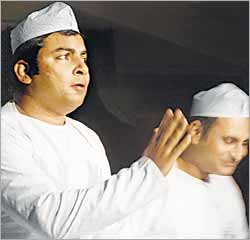
Urdu tales take centre-stage
Two men clad in pristine white, surma-eyed, regale a slightly unsure audience with stories of warfare, trickery and sorcery. That’s ‘dastangoi’ for you – a lost form of storytelling in Urdu. Bringing it back and to Prithvi this weekend are Mahmood Farooqui and Danish Hussain.
“Dastangos were those who told ‘dastans’ (stories). Recounting tales of Amir Hamza, the Prophet Mohammed’s uncle, they told narratives of his battles with infidels, sorcerers and other pretenders to divinity,” says Farooqui.
This performance consists of portions of the best-known ‘daftar’ or chapter, of the 46 volume Dastan-e-Amir Hamza, the Tilism Hoshruba or ‘enchantment that steals away the senses’.
“Because this form died out about 120 years ago, we had nothing to draw from in terms of presentation. We’re still evolving the form to suit performance values,” says Farooqui, a self-trained actor from Delhi.
One would think that as Urdu is usually considered a language of erudition and poetry, following an entire story in the language wouldn’t be everyone’s cup of tea. “It is only in the beginning of the performance that people are a little hesitant,” says Hussain.
“They usually pick up a thread soon and they’re just sucked in by the magic of it all.”
No comments:
Post a Comment